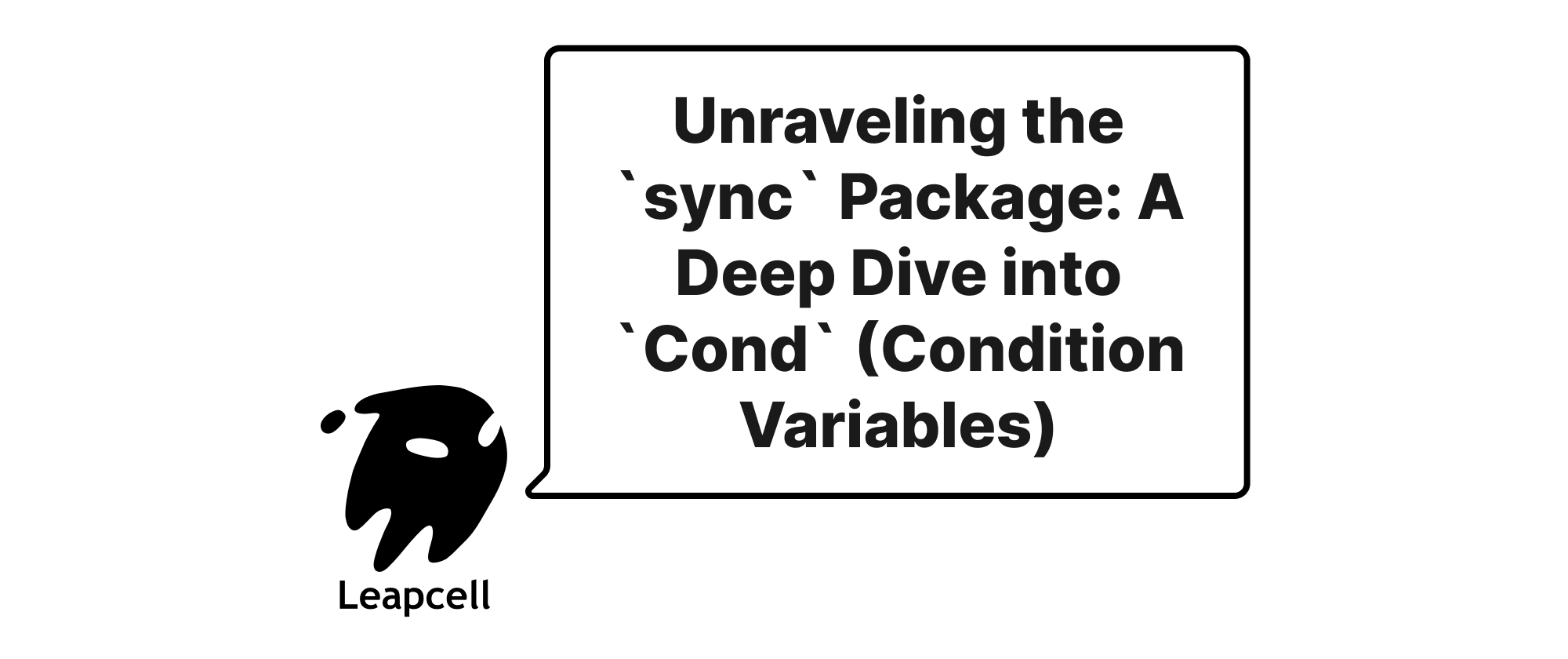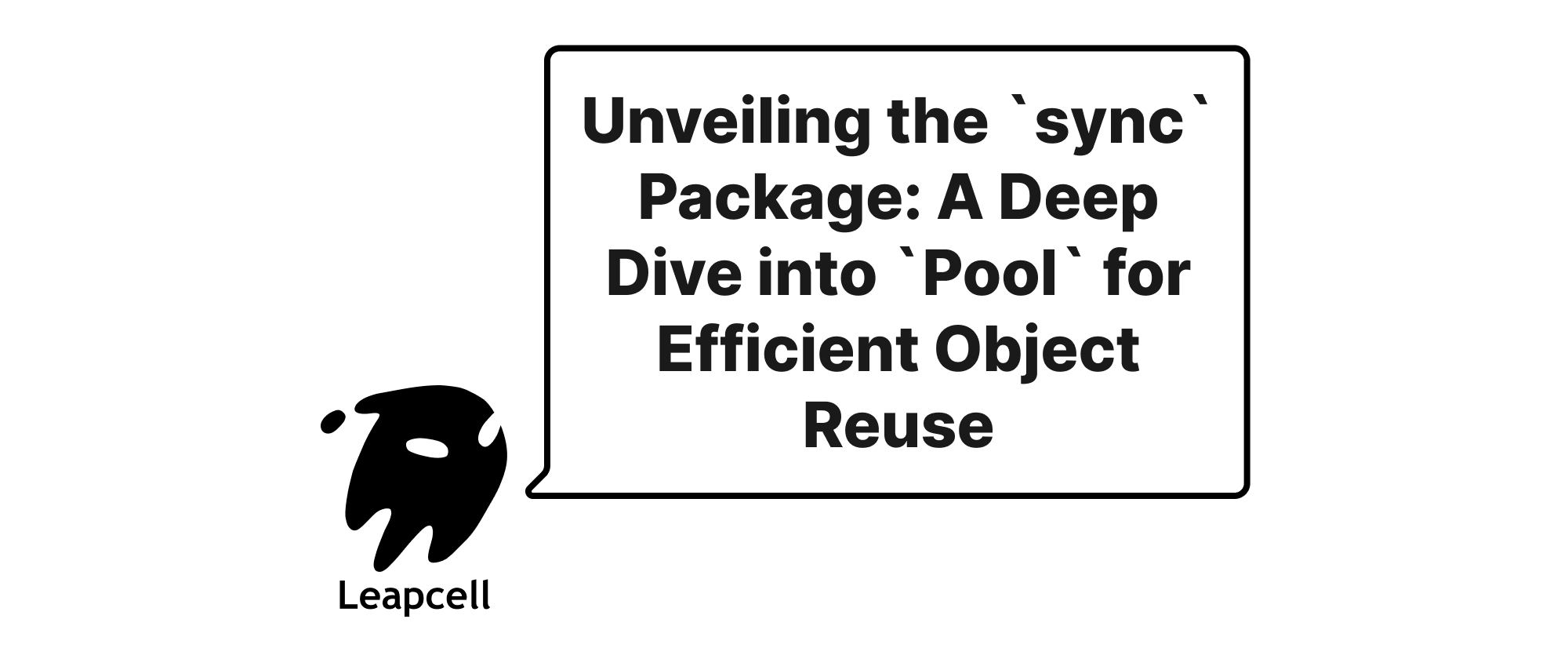Unraveling the Go sync Package: A Deep Dive into Cond for Concurrent Coordination
Grace Collins
Solutions Engineer · Leapcell

The Go sync package is a cornerstone of concurrent programming in the language, providing fundamental building blocks like Mutex, RWMutex, WaitGroup, and Once. Among these, sync.Cond stands out as a powerful primitive for coordinating Goroutines that need to wait for a specific condition to become true before proceeding. This article delves into sync.Cond, explaining its mechanics, its relationship with mutexes, and showcasing其usage with practical examples.
Introduction to Condition Variables
A condition variable, as provided by sync.Cond in Go, is not a boolean flag or a counter itself. Instead, it's a mechanism that allows Goroutines to wait for a condition to be met, and other Goroutines to signal that the condition might have changed. It's crucial to understand that sync.Cond always works in conjunction with a sync.Locker (typically a sync.Mutex or sync.RWMutex). The locker protects the shared state that the condition variable monitors.
The core idea is:
- A Goroutine wants to proceed but a condition isn't met. It acquires the associated mutex, checks the condition, and if it's false, calls
Cond.Wait(). Cond.Wait()performs three critical actions atomically: a. It releases the associated mutex. b. It suspends the Goroutine, adding it to a wait queue. c. When signaled, it reacquires the associated mutex before returning.- Another Goroutine changes the shared state, potentially satisfying the condition. It acquires the associated mutex, modifies the shared state, and then calls
Cond.Signal()orCond.Broadcast()to notify waiting Goroutines.
Anatomy of sync.Cond
Let's look at the sync.Cond structure and its key methods:
type Cond struct { noCopy noCopy // Ensures Cond is not copied L NoCopyLocker // The locker associated with c. // contains filtered or unexported fields }
L sync.Locker: This is the mutex (orsync.RWMutex) thatCondis bound to. It must be held whenWaitis called and when the shared condition is checked or modified.
Key Methods
-
func NewCond(l Locker) *Cond: Creates and returns a newCondvariable associated with the providedLocker. -
func (c *Cond) Wait():- Must be called with
c.Llocked. - Atomically unlocks
c.L, suspends the calling Goroutine, and then relocksc.Lwhen it's signaled and the Goroutine is woken up. - Crucially, when
Waitreturns, the condition might still be false. This is known as a spurious wakeup. Therefore,Waitshould always be called inside a loop that re-checks the condition.
- Must be called with
-
func (c *Cond) Signal():- Wakes up at most one Goroutine waiting on
c. - If no Goroutines are waiting, it does nothing.
- Does not require
c.Lto be locked by the caller, but it's often called whenc.Lis locked because the shared state (which necessitated the signal) has just been modified.
- Wakes up at most one Goroutine waiting on
-
func (c *Cond) Broadcast():- Wakes up all Goroutines waiting on
c. - If no Goroutines are waiting, it does nothing.
- Like
Signal, it does not requirec.Lto be locked by the caller.
- Wakes up all Goroutines waiting on
Why Cond and Mutex? What's the Synergy?
The Mutex provides mutual exclusion, ensuring that only one Goroutine can access shared data at a time, preventing race conditions during data modification. However, a Mutex alone doesn't provide a way for Goroutines to efficiently wait for a condition to become true without busy-waiting (spinning in a loop and constantly acquiring/releasing the mutex, consuming CPU cycles).
This is where Cond comes in. It addresses the waiting problem:
Mutexprotects the shared state. When you read or modify the state that your condition depends on, you hold the mutex.Condhandles the waiting/notification. When a Goroutine needs to wait for the state to change, it usesCond.Wait(). When a Goroutine changes the state such that others might be unblocked, it usesCond.Signal()orCond.Broadcast().
Think of it this way: Mutex protects access to the meeting room. Cond is the doorbell in the waiting area that tells people on the couches that the meeting on the agenda might be starting.
Practical Example 1: Producer-Consumer Problem
A classic use case for condition variables is the Producer-Consumer problem, where producers add items to a buffer and consumers remove them. If the buffer is full, producers must wait. If it's empty, consumers must wait.
package main import ( "fmt" "sync" "time" "math/rand" ) const ( bufferCapacity = 5 numProducers = 2 numConsumers = 3 itemsPerProducer = 10 ) // Shared state var ( buffer []int cond *sync.Cond mu sync.Mutex itemCount int ) func producer(id int) { for i := 0; i < itemsPerProducer; i++ { // Acquire mutex before checking/modifying buffer cond.L.Lock() // Same as mu.Lock() since cond.L is mu // Wait if the buffer is full for len(buffer) == bufferCapacity { fmt.Printf("Producer %d: Buffer full, waiting...\n", id) cond.Wait() // Releases mu, waits, reacquires mu } // Produce item item := rand.Intn(100) buffer = append(buffer, item) itemCount++ fmt.Printf("Producer %d: Produced item %d. Buffer: %v\n", id, item, buffer) // Signal consumers that an item is available cond.Signal() // Potentially wakes up one consumer // cond.Broadcast() // Would wake up all waiting consumers (less efficient here) cond.L.Unlock() // Release mutex time.Sleep(time.Duration(rand.Intn(200)) * time.Millisecond) // Simulate work } fmt.Printf("Producer %d finished.\n", id) } func consumer(id int) { for { cond.L.Lock() // Acquire mutex // Wait if the buffer is empty for len(buffer) == 0 { if itemCount >= numProducers*itemsPerProducer && len(buffer) == 0 { fmt.Printf("Consumer %d: No more items expected, exiting.\n", id) cond.L.Unlock() return // All items produced and consumed } fmt.Printf("Consumer %d: Buffer empty, waiting...\n", id) cond.Wait() // Releases mu, waits, reacquires mu } // Consume item item := buffer[0] buffer = buffer[1:] fmt.Printf("Consumer %d: Consumed item %d. Buffer: %v\n", id, item, buffer) // Signal producers that space is available cond.Signal() // Potentially wakes up one producer cond.L.Unlock() // Release mutex time.Sleep(time.Duration(rand.Intn(300)) * time.Millisecond) // Simulate work } } func main() { rand.Seed(time.Now().UnixNano()) cond = sync.NewCond(&mu) // Associate cond with our mutex fmt.Println("Starting producer-consumer simulation...") go func() { // Start producers for i := 0; i < numProducers; i++ { go producer(i + 1) } }() go func() { // Start consumers for i := 0; i < numConsumers; i++ { go consumer(i + 1) } }() // Wait for a sufficient amount of time to allow operations to complete // In a real application, you might use a WaitGroup or a channel for graceful shutdown. time.Sleep(5 * time.Second) fmt.Println("\nSimulation finished.") }
Explanation of the Producer-Consumer Example:
bufferandmu(mutex) are shared resources.itemCounthelps consumers know when to exit if all items are produced.cond = sync.NewCond(&mu)binds the condition variable to our mutex.- Producer Logic:
- It locks
mu(viacond.L.Lock()). - It enters a
forloop:for len(buffer) == bufferCapacity. This is the crucial re-check loop. If the buffer is full, it callscond.Wait().Waitunlocksmu, suspends the Goroutine, and will relockmuwhen it's woken up. When it wakes up, it re-evaluates the condition. - If the buffer is not full, it adds an item, increments
itemCount. cond.Signal()is called to notify one waiting consumer that an item is available.- Finally,
mu.Unlock()is called.
- It locks
- Consumer Logic:
- Similar structure: Locks
mu. - Enters a
forloop:for len(buffer) == 0. If the buffer is empty, it callscond.Wait(). - It includes an additional check to determine if all items have been produced and consumed, to allow for graceful exit.
- If an item is available, it consumes it.
cond.Signal()is called to notify one waiting producer that space is available.- Unlocks
mu.
- Similar structure: Locks
This example clearly demonstrates how Cond.Wait() efficiently yields the CPU when a condition isn't met, and Cond.Signal() efficiently resumes a waiting Goroutine when the condition might have changed.
Practical Example 2: Ordered Execution (Simple Barrier)
Sometimes, you need Goroutines to wait until a certain number of tasks are completed or a specific state is reached before all of them can proceed. This is akin to a simple barrier.
package main import ( "fmt" "sync" "time" ) const numWorkers = 5 var ( mu sync.Mutex cond *sync.Cond readyCount int // Number of workers ready to proceed allReady bool ) func worker(id int) { fmt.Printf("Worker %d: Initializing...\n", id) time.Sleep(time.Duration(id*100) * time.Millisecond) // Simulate prep work cond.L.Lock() // Lock to modify shared state (readyCount, allReady) readyCount++ fmt.Printf("Worker %d: Ready. Total ready: %d\n", id, readyCount) // If this worker is the last one to become ready, signal all if readyCount == numWorkers { allReady = true fmt.Printf("Worker %d: All workers are ready! Signaling everyone.\n", id) cond.Broadcast() // Wake up all waiting workers } else { // Otherwise, wait until all others are ready for !allReady { fmt.Printf("Worker %d: Waiting for others to be ready...\n", id) cond.Wait() // Releases mu, waits, reacquires mu } } cond.L.Unlock() // Release the lock fmt.Printf("Worker %d: Proceeding with synchronized task!\n", id) // Simulate synchronized task time.Sleep(time.Duration(100) * time.Millisecond) fmt.Printf("Worker %d: Synchronized task completed.\n", id) } func main() { cond = sync.NewCond(&mu) var wg sync.WaitGroup fmt.Println("Starting workers...") for i := 0; i < numWorkers; i++ { wg.Add(1) go func(id int) { defer wg.Done() worker(id) }(i + 1) } wg.Wait() // Wait for all workers to complete their tasks fmt.Println("All workers finished. Exiting.") }
Explanation of the Ordered Execution Example:
readyCounttracks how many workers have reached the synchronization point.allReadyis a boolean flag indicating if all workers have met the condition (all are ready).- Each
workerGoroutine- Does some preliminary work.
- Acquires the mutex (
cond.L.Lock()). - Increments
readyCount. - Crucial Logic:
- If it's the last worker to become ready (
readyCount == numWorkers), it setsallReady = trueand callscond.Broadcast(). This wakes up all other workers currently callingcond.Wait(). - If it's not the last worker, it enters the loop
for !allReadyand callscond.Wait(). It will wait untilallReadybecomes true, which will be signaled by the last worker.
- If it's the last worker to become ready (
- After
cond.Wait()returns (and the mutex is re-acquired), or if it was the last worker and broadcasted, it releases the mutex and proceeds with the synchronized task.
This demonstrates Broadcast for scenarios where multiple Goroutines need to be released simultaneously upon a single triggering event.
Important Considerations and Best Practices
- Always use
Waitinside a loop: As mentioned,Waitcan experience spurious wakeups (waking up without aSignalorBroadcast). Your condition check (for !condition { cond.Wait() }) is vital to handle this and re-evaluate the state. - Hold the mutex when calling
Wait:cond.Wait()expects theCond's associatedLockerto be held by the caller. It automatically releases it and reacquires it. - Hold the mutex when checking/modifying the condition: Any read or write of the shared state that your condition depends on must be protected by the
Cond's associatedLocker. Signalvs.Broadcast:- Use
Signal()when at most one Goroutine can proceed or benefit from the state change (e.g., one item available in a buffer, so only one consumer can take it). - Use
Broadcast()when all waiting Goroutines might need to react (e.g., a shutdown signal, all workers should stop; or a global state change that impacts everyone).Broadcastis generally less efficient due to a thundering herd problem (all Goroutines wake up, contend for the mutex, and most might go back to sleep).
- Use
- Placement of
Signal/Broadcast: You can callSignal/Broadcasteither before or after releasing the mutex.- Calling before releasing the mutex makes the
Waiting Goroutines contend for the mutex as soon as they wake up. This could be slightly faster if the mutex is immediately available. - Calling after releasing the mutex ensures the mutex is already free for the waking Goroutines.
- Generally, it doesn't significantly matter from a correctness standpoint, but consider the performance implications in high-contention scenarios. For simplicity and allowing the signalling Goroutine to finish its critical section before waking others, many patterns put the signal after the unlock, but after the status change that released the dependencies. My examples above illustrate calling it before the unlock, which is also a common pattern.
- Calling before releasing the mutex makes the
- Avoid Deadlock: Ensure that if a Goroutine waits, there is another Goroutine that eventually signals it, or a mechanism for graceful shutdown. A common mistake is for all Goroutines to wait and none to signal.
- Consider
context.Contextfor cancellation: For more complex scenarios, especially with long-running operations or network interactions, integratingcontext.Contextwithselectstatements and channels can provide a more robust way to handle timeouts and cancellations alongsidesync.Cond.
Conclusion
sync.Cond is an essential tool in Go's concurrency toolbox, enabling efficient coordination between Goroutines that depend on specific conditions being met. By understanding its close relationship with sync.Locker (especially sync.Mutex) and adhering to best practices like loop-based waiting and judicious use of Signal vs. Broadcast, you can build robust and performant concurrent applications. It allows Goroutines to sleep until genuinely needed, conserving CPU cycles and improving the overall efficiency of your concurrent Go programs. As you venture into more complex concurrent designs, the nuanced control offered by sync.Cond will prove invaluable.


